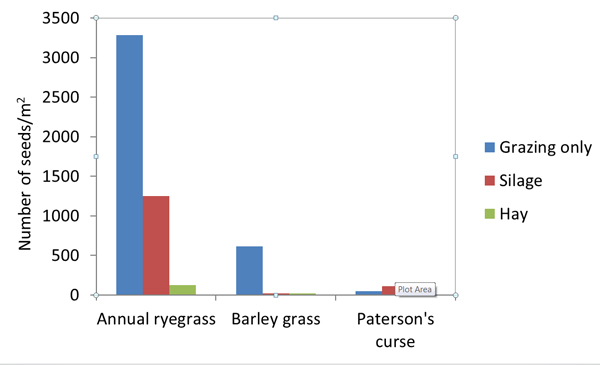Preparing paddocks for pasture sowing next year
Now is the time to be thinking about which paddocks you may be intending to resow to pasture for next year. Reducing weed seed burdens in paddocks to be sown to pasture is absolutely critical for the successful establishment of new pasture sowings.
Often, we don’t give a lot of consideration to how much weed seed is in a paddock, but it is critical to do so. Dr Annabel Bowcher completed a very comprehensive study on weed seed banks in southern NSW in the late 1990’s.
Dr Bowcher found 35% of the paddocks surveyed contained more than 15 000 annual grass seeds per square metre and 50% of paddocks had more than 5000 broadleaf weeds per square metre. Reducing this weed seed contamination is critical prior to sowing any new pasture.
Generally, it is advisable to have a three year clean-up program prior to sowing a paddock down to a new pasture. There are a number of strategies that can be used to reduce weed seed banks prior to pasture sowing. These include cropping paddocks for three years and not allowing any weed seed set in that time – including over summer in stubbles, winter cleaning, spraytopping, making silage or hay, grazing and spray grazing.
As an example of tactics, Dr Bowcher’s studies examined the impact of three years of grazing, silage making or hay making on the seedbank of a number of weeds in a rundown pasture (Figure 1). Grazing alone was the least effective means of reducing weed seedbank levels of annual ryegrass and barley grass.
Haymaking (cutting early November) was the most effective means of reducing the annual ryegrass seedbank while either silage making (late October cutting) and haymaking were equally effective in reducing barley grass seedbank. There was little difference in the three tactics in on broadleaf weed seedbank numbers.

Figure 1: The number of weed seeds present per square metre in a rundown perennial pasture following three years of grazing, silage making or hay making at Wagga Wagga, NSW. (source: Bowcher 2002).
The effectiveness of these strategies could be expected to change with season as in very dry years, a late cutting regime may allow more seed to be produced as plants enter the reproductive stage of their lifecycle earlier. Similarly, if a very wet spring is experienced, then weeds may recover after cutting and go on to produce seed.
Therefore, wherever possible, combine a number of tactics in attempting to drive down the weed seedbank. For example, had the paddock in this example being grazed after cutting or a herbicide treatment applied then the seedbank would be expected to have been further reduced.
So if you have paid diligent attention to reducing the weed seed bank, then the next step is to consider what you are going to sow next autumn and your sowing rate. Producers often identify seed cost as a significant issue in determining how much of a given species they are going to sow per hectare. However, reducing the sowing rate of a pasture in an attempt to reduce costs can be a false economy.
Lets consider a fairly typical scenario. Say for example you are intending to sow a subterranean clover based pasture. A fairly typical sowing rate for subterranean clover is around 4 kg/ha. You could expect that a common mid-season maturity subterranean clover variety to have somewhere around 110 000 seeds/kg. So if you sow 4 kg/ha, that’s 440 000 seeds/ha or 44 seeds/m2.
If we refer back to Dr Bowcher’s study, then the best result achieved for annual ryegrass after three years of clean-up was 125 seeds/m2. So there are still three times as many ryegrass seeds compared to the number of subterranean clover seeds you are sowing. In a competition between subterranean clover and annual ryegrass at establishment, the ryegrass will invariably win given this advantage in numbers.
So be prepared to be ruthless in setting up paddocks for new pasture sowings. Ensure you have three years of highly successful weed control prior to sowing a new pasture wherever possible and be mindful of sowing rates to give your new sown pasture the best chance of success.